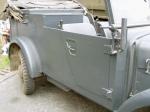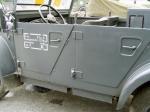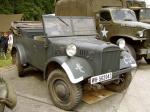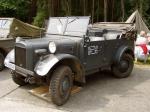Stoewer R180S (lichte Einheits-Pkw - lEpkw; 1936-39)
English Version
 |
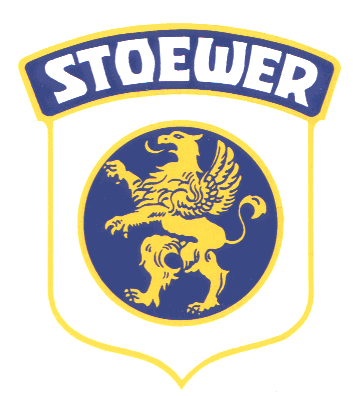 |
| Logo |
Logo |
Historique Les origines de ce véhicule remontent à 1928/29 et dans le Programme de Motorisation de
l‘armée Allemande ( Kraftfahrrustungs programm )qui subdivise les différentes catégories de véhicules militaires en catégories légères moyennes Lourdes et qui standardisent l ensemble en définissant les équipements selon les usages via le système de numération Kfz .
En 1934 suite à l ‘élection d’Hitler à la Chancellerie un vaste programme de réarmement voit le jour en Allemagne pour toutes les branches militaires (Air Terre Mer ) Chaque branche reçoit des nouveaux équipements et voient ses moyens financiers accrus
Pour la Heer il est prevu le remplacment des vehicules de liason de1° generation issus du Kraftfahrrungsprogramm par de nouveaux vehicules de 2°generation issus du Einheitsprogramm (Programme Standard). Si les taches dévoluent à ces véhicules restent sensiblement les mêmes c’est l’équipement de ceux ci qui changent avec de nouvelles radios, des téléphones de campagne, de même que la carrosserie. Alors que les véhicules nés du Kraftfahrrungsprogramm n’étaient que des vehicules issus de la gamme civile avec le minimum de militarisation ceux issus du Einheitsprogramm sont des véhicules spécialement conçus pour une utilisation militaire.
Production.
Pour chaque catégorie de véhicule il est prevu un seul constructeur qui dirige le programme et est responsable de A à Z ( prototypes essais fabrication ) Pour la catégorie des voitures de liaison légères (lEpkw) c’est la firme Stoewer de Stettin qui est choisie en 1936 . En 1937 BMW de Eisenach et Hanomag d’ Hanovre rejoignent le programme . La différences entres les vehicules sortant des chaînes de fabrications portera surtout sur la motorisation et quelques différence mineures.
Description
Ce véhicule coûteux long et complexe à produire est un 4X4 permanent L’option 4X2 date de 1940. Il a une boite à vitesses ZF à 5 vitesses un équipement électrique de 12 volts La suspension de chaque roue est indépendante Pour réduire les coûts de fabrication les efforts ont portés sur la caisse et les organes de transmissions mais pas sur la motorisation qui voit 5 types de moteurs être utilisés entre 1936 et 1944
La caisse standardisée est construite de façon traditionnel en bois recouvert de plaques de métal . Elle possède 4 sièges et 4 portes pour la version Kfz 1 et Kfz 3, 3 sièges et 3portes pour la version radio, téléphone Kfz 2 ou atelier Kfz 2/40 et 2 sièges 4 portes pour la version Kfz 4 avec des mitrailleuses anti aériennes jumelées . Toutes ces versions possèdent les portes en fer, des vitres des sièges baquets, un pare brise pliages et les houses de protections
 |
| Kf 4 Source Internet |
Ce véhicule aura un succes mitigé du à la complexité de sa mécanique qui nécessite beaucoup d’entretien et des problème en tout terrain. De plus elle est limité en charge utile et ne peut pas tracter des remorques. Le Front de l Est sera impitoyable avec ce type de machine
Stoewer R180S au combat
Ce Vehicle construit a environ 17500 exemplaires a été utilisé sur touts les fronts. Il a reçut divers noms dont le plus usuel est “Kubelwagen”, alors que son nom officiel est Kubelsitzerwagen ce qui veut dire pour les vehicules issus du Kraftfahrrungsprogramm Véhicules de liason hard top Le terme Kubelwagen vient du milieu sportif et est issu du nom Kubelsitzerwagen ce qui veut dire voiture à siège baquet. Le terme sera abrégé en Kubel .
Caractéristiques
Constructeur principal
Stoewer-Werke G.m.b.H.
Autres Constructeurs
BMW A.-G.model Type 325
Hanomag model Type 20 B
Model Type Stoewer R180 S
Numérotation Sd Kfz Kfz 1, 2, 2/40, 3, 4
Poids 1775 kg
PTAC 2200 kg
Longueur 3900 mm
largeur 1690 mm
Hauteur 1900 mm
Moteur
Stoewer R18 W, essence 4 cylindres OHV, refroidi par eau, 1757 cm3 42 CV,
BAV/Transmission
ZF 5 avant, 1 arrière
Autonomie
Route 350 km, Tout terrain 240 km
Vitesse
80 km/hr
Autre phototheque Other Walk Around 1 2 3
Voir Aussi Autre Photoscope See Also Other Walk Around
Horch 901 Funkwagen Kfz 17 -radio FU 11 SE 100
Mercedes G 5 1938 Rome
Mercedes G 5 1938 Spire
BMW 325 model 1938 Fort Miles USA
Stoewer R180S lichte Einheits-Pkw - lEpkw
Stoewer R180S lichte Einheits-Pkw - lEpkw
Stoewer R180S lichte Einheits-Pkw - lEpkw
Stoewer R180S lichte Einheits-Pkw - lEpkw
3Stoewer R180S (lichte Einheits-Pkw - lEpkw; 1936-39)
 |
 |
| Logo |
Logo |
Design and developement
The origins of this vehicle date from the 1928-29 German Army Kraftfahrrustungs- programm (Motorisation Programme) that had for the first time given a definitive design brief for a military field car, plus dividing them into light. medium and heavy categories and additionally defining their usage and equipment levels via the new Kfz numbering system..
In 1934 following the election of Adolf Hitler to the Chancellorship of Germany and with him the Nazi Party control of Germany, a widespread rearmament’s programme was introduced for the Army, Airforce and Navy, All were to have new equipment and enlarged manpower.
For the armies vehicles, and in particular their field cars, this meant the replacement of the previous 1st generation Kraftfahrrungsprogramm vehicles with new light, medium and heavy field cars of the 2nd generation Einheitsprogramm (Standard Programme). Whilst the equipment carried by these vehicles remained very much the same as before, i.e. various radios, field telephones, survey equipment, machine guns etc., the individual light, medium and heavy vehicle designs were radically different. Gone were the Kraftfahrrungsprogramm specifications which used modified existing civilian vehicles from across the whole of the German motor industry, to that of using specifically designed military chassis from just a selected few of those manufacturers. Even then several makers were grouped together to manufacture the same design of field car.
Production
Within each light, medium and heavy grouping one manufacturer was designated to be the prime contractor. They were responsible for the initial design, prototypes, trials, and first-off manufacture, plus initiating and controlling any on-going changes. For the light field car (lEpkw) Stoewer of Stettin was chosen in 1936, with BMW of Eisenach and Hanomag of Hanover joining the manufacturing programme in 1937 The only subsequent difference between the vehicles from these three manufacturers was the use of their own engines, albeit of a similar cubic capacity and dimensions.
Technical specifications
This design of light field car had permanent 4 x 4 drive, optional 4-wheel steering (changed to 2-wheel steering only from late 1940 onwards), large 600-18 tyres, 12 volt electric’s, 5 speed ZF gearbox and all round independent suspension, with every individual component supplied to Stoewer, BMW and Hanomag, coming from exactly the same source, except the engines as previously mentioned.
These were costly and complex vehicles, and although significant cost savings were made from having the one chassis design, the engine story was quite different. In all there were five engine designs used for the standard light field car during its production from 1936 to 1944
Equipement The bodywork was constructed along traditional lines using a wooden framework covered in sheet steel, and also standardised to be either 4 seats/4 doors (general use kfz 1 or survey equipment kfz 3), 3 seats/3 doors (radio, telephone kfz 2 or maintenance tools kfz 2/40), or 2 seats/4 doors (twin MG flak kfz 4). All these variations had steel doors. sidescreens, bucket seats, fold down windscreens and folding hoods.
 |
| Kf 4 (Source Internet ) |
This cars were a mixed success, du to his mechanical complexity which led an high levels of maintenance, and problems in all-terrains. Also she was limited in carrying capacity and she can not towing anything . The Eastern Front will be pitiless for this kind of material
Stoewer R180S during WW2
These vehicles were used throughout W.W.II on all fronts and a total of approximately 17,500 were built, with BMW and Hanomag ending production in late 1940, whilst Stoewer continued until April 1944.
These Einheits field cars were also given the slang name of “Kubelwagen”, as were all the previous and subsequent field car programme vehicles. Originally this was Kubelsitzerwagen and applied to all the earlier Kraftfahrrungsprogramm field cars due to their very open and doorless bodywork. To compensate for such little bodywork the crew seats were of a wrap-around design commonly known in racing and sports car circles as “Bucket Seats”, and Kubelsitzerwagen literally means Bucket Seat Vehicle, usually shortened to Kubelwagen or Kubel.
Technical Data
Manufacturer
Stoewer-Werke G.m.b.H.
Secondary Manufacturers
BMW A.-G.model Type 325
Hanomag model Type 20 B
Model Type Stoewer R180 S
Sd Kfz Number Kfz 1, 2, 2/40, 3, 4
1775 kg Weight Laden
2200 kg
Length3900 mm
Width 1690 mm
Height 1900 mm
Engine
Stoewer R18 W, petrol 4 cylinder OHV, Water cooled, 1757 cc 42 HP,
Gearbox/transmission
ZF 5 forward, 1 reverse
Range
Road 350 km, off-road 240 km
Maximum Speed
80 km/hr






